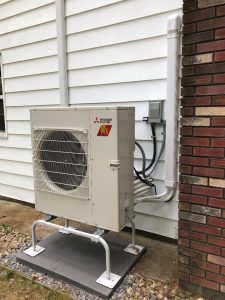
Courtesy of Suburban Services Group
By Christine Graf
For homeowners looking to save money on heating and cooling costs, heat pumps may be the answer. Heat pumps operate using electricity, extracting heat from outside, bringing it indoors to heat a home during winter. Conversely, the pumps move heat from indoors to outdoors during the summer.
Although heat pumps have been commercially available since the late 1940s, it wasn’t until the energy crisis of the 1970s that their popularity increased. As fuel prices skyrocketed, people looked for more cost-effective ways to heat and cool their homes.
According to Craig MacDonald, owner of Suburban Services Group in Burnt Hills, heat pumps declined in popularity as fossil fuel heating equipment was mandated and engineered for much higher efficiency.
“We’ve been installing heat pumps for 30 years, and most people remember that the old heat pumps blew cool air and were often inefficient compared to oil or propane heat. Over time, they fell out of favor as furnace technology improved. But because of improvements in heat pump technology, today’s heat pumps are capable of heating many homes in cold climates.”
In recent years, heat pumps have been re-engineered, enabling them to recover significantly more heat from the outdoors. Unlike conventional heat pumps, these cold climate heat pumps are ideal for those living in Northern New York and New England.
“The original heat pumps were designed to heat until it reached around freezing outdoors,” said MacDonald. “In the last five years, they have made significant improvement in the technology. Cold climate heat pumps are now able to run when it is double digits below zero outside.”
Determining whether or not a cold climate heat pump could replace a traditional furnace in a person’s home requires an assessment by a heating and cooling industry professional.
“You need to have somebody who has been trained and schooled in the application and installation of heat pumps,” said MacDonald. “It depends on construction of the home, but a well-engineered heat pump system can replace the furnace or central heat in most homes.”
While installation costs for cold climate heat pumps are typically higher than for conventional furnaces, cold climate heat pumps provide high efficiency air conditioning in addition to heat. In many applications, they also reduce a homeowner’s energy costs.
“When you consider your energy cost to heat your house, if you have oil or LP gas (propane), the heat pump very often makes a lot of sense and costs less to run,” said MacDonald. “Today’s heat pumps will also cool your spaces – usually at a much lower electric cost than the typical central air conditioning units.”
The demand for cold climate heat pumps has risen in recent years, in part because of the United States’ efforts to reduce the use of fossil fuels. Tax incentives and rebates have also been significant drivers for increasing demand.
“This makes them more affordable than they were in the past. It also reduces the cost of energy to heat your house, which makes them very attractive,” said MacDonald. “Proper application of various models – whether they are whole house or ductless systems–will produce consistent and comfortable heat.”
Cold climate heat pumps are also ideal for spaces that are difficult to heat or cool.
“That might include a three-season room you would love to use year round,” he said.
For more information, visit suburbanservicesgroup.com. A Mitsubishi Diamond Cold Climate Heat Pump contractor, Suburban Services also installs and services other types of heating and cooling systems.
